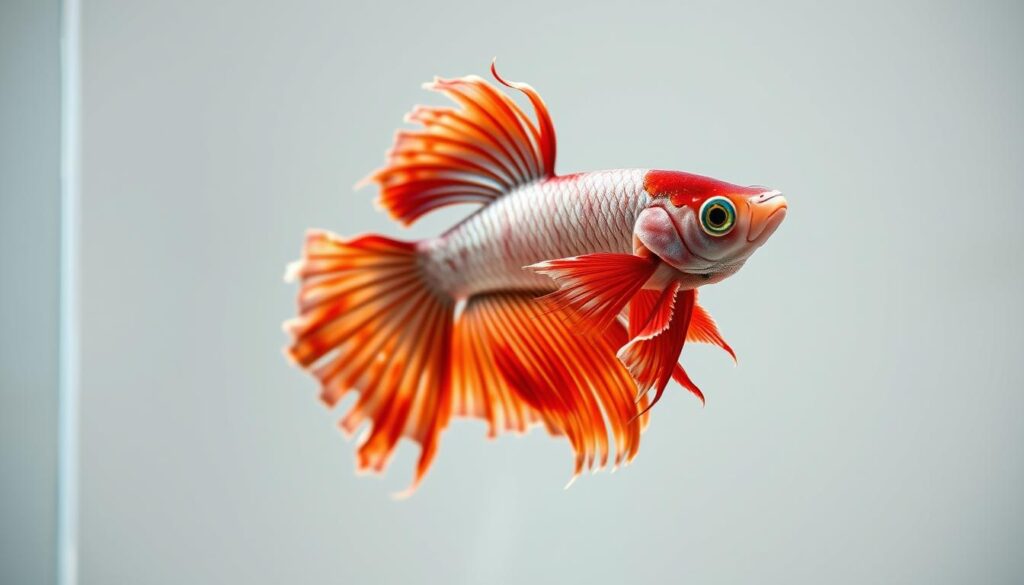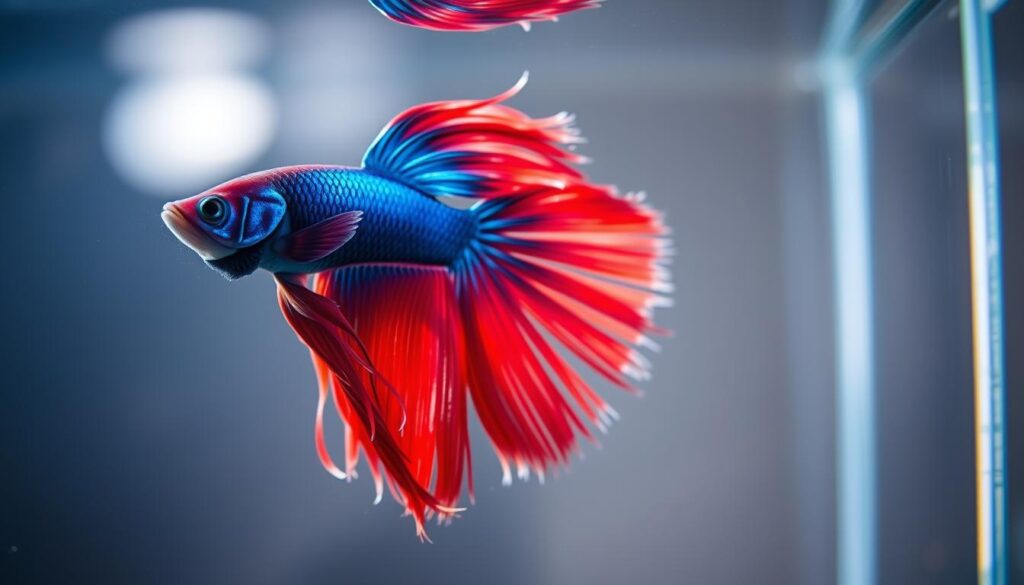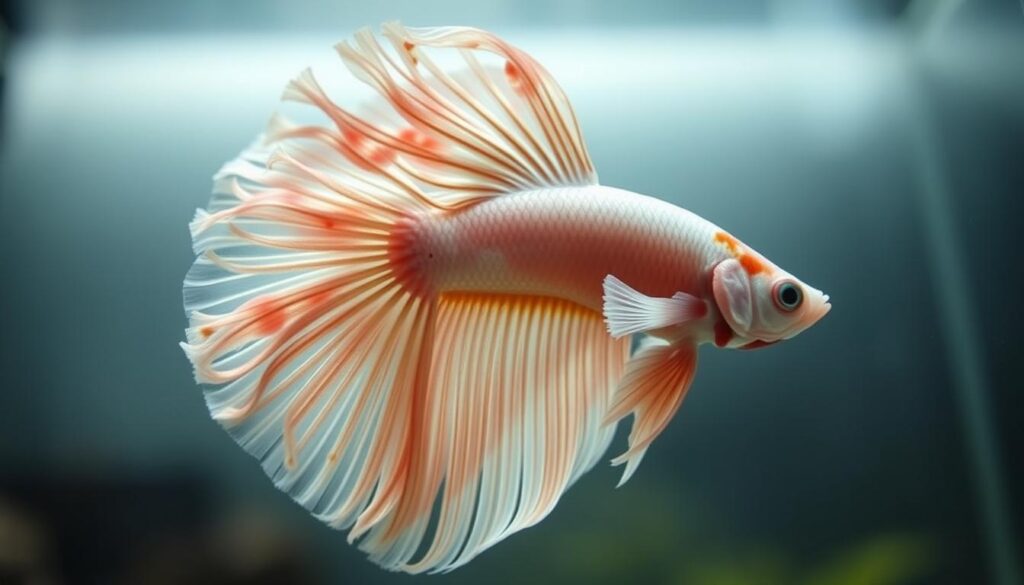Veiltail Betta Fin Rot is a common yet concerning issue for Betta fish owners. Known for their long, flowing tails, Veiltail Bettas are especially vulnerable to fin rot due to their delicate fins. This bacterial or fungal infection can cause the fins to appear torn, discolored, or shortened—dimming the beauty of your Betta and threatening its health.
The good news? With the right care and treatment, including clean water and natural remedies like aquarium salt, your Veiltail Betta can recover and thrive. In this guide, we’ll explore the causes, symptoms, and effective treatments to help your Betta heal fast.
Fin rot is a frequent issue in veiltail bettas, usually caused by bacterial or fungal infections due to poor water quality or stress. Don’t worry, we’ve got you covered! In this article, we’ll explore the main causes, symptoms, and treatment options for this condition, helping you take the first step towards keeping your betta healthy and thriving.
Key Takeaways
- Understand the common causes of fin rot in veiltail bettas.
- Learn to identify the symptoms of fin rot.
- Discover effective treatment options for fin rot.
- Find out how to prevent fin rot in your veiltail betta.
- Get tips on maintaining a healthy environment for your betta.
Understanding Veiltail Bettas and Their Unique Fins
Veiltail bettas are a marvel of aquatic beauty, with their elaborate fins being a major draw for many aquarium enthusiasts! These stunning creatures have captured the hearts of many with their flowing, elegant fins. But what makes them so special, and why do their fins require extra care?
Characteristics of Veiltail Bettas
Veiltail bettas are known for their long, flowing fins that can grow up to 3-4 inches in length, making them a popular choice among betta enthusiasts. Their elaborate tail fins are not just beautiful; they’re also a key characteristic that defines this betta type. With proper care, veiltail bettas can thrive and become a centerpiece in any aquarium.
Why Veiltail Fins Are Particularly Vulnerable
The long, flowing fins of veiltail bettas are prone to damage and infection, making them more vulnerable than other betta types. This is because their fins are more susceptible to fin nipping and can easily get caught on sharp decorations or plants in the tank. Moreover, poor water quality can lead to fin rot, a common issue in veiltail bettas.
Typical Lifespan and Health Considerations
With proper care, veiltail bettas can live for around 3-5 years. However, their lifespan can be affected by various health issues, including fin rot, bacterial infections, and poor water quality. Regular water changes, a balanced diet, and a stress-free environment are crucial for maintaining their health and ensuring they thrive.
By understanding the unique characteristics and needs of veiltail bettas, you can provide the best possible care for these beautiful creatures. Whether you’re a seasoned betta keeper or a newcomer to the world of aquarium fish, knowing how to care for your veiltail betta is key to keeping them healthy and happy.
What Is Fin Rot in Veiltail Bettas?
As a veiltail betta owner, you’ve likely heard of fin rot, but do you know what it is and how it affects your fish? Fin rot is a condition that can be quite distressing for both you and your pet. Let’s dive into understanding this common issue.
Definition and Overview of the Condition
Fin rot is a bacterial or fungal infection that causes the deterioration of a betta’s fins. It’s characterized by fraying, discoloration, and eventual loss of fin tissue. This condition can progress rapidly if not addressed promptly.
How Fin Rot Differs from Natural Fin Deterioration
It’s essential to distinguish fin rot from natural fin deterioration, which can occur due to aging or minor injuries. Fin rot is typically marked by a more rapid decline in fin health, often accompanied by visible signs of infection such as redness, swelling, or a fuzzy appearance.
To help you understand the difference, consider the following comparison:
| Characteristics | Fin Rot | Natural Fin Deterioration |
|---|---|---|
| Progression Rate | Rapid | Gradual |
| Visible Signs | Redness, swelling, fuzzy appearance | Minor fraying, slight discoloration |
| Cause | Bacterial or fungal infection | Aging, minor injury |
The Impact on Betta Fish Health
Fin rot can have a significant impact on your veiltail betta’s overall health. If left untreated, it can lead to more severe infections, affecting your fish’s quality of life and even its lifespan. By understanding the causes and symptoms of fin rot, you can take prompt action to protect your pet.
“The key to saving your veiltail betta’s fins is early detection and treatment. Don’t wait until it’s too late!”
By recognizing the signs of fin rot and taking action, you can help your veiltail betta recover and thrive.
Read Also Betta Fish Names: Unique and Meaningful Options for Your Pet
Common Causes of Fin Rot in Veiltail Bettas
As a betta owner, you’ve probably heard of fin rot, but do you know what causes it in veiltail bettas? Fin rot is a common issue that can be triggered by a variety of factors, and understanding these causes is crucial to preventing and treating the condition.
Poor Water Quality and Parameters
One of the primary causes of fin rot in veiltail bettas is poor water quality. When the water is dirty or contains high levels of toxins, it can lead to bacterial and fungal infections that damage the fins. Regular water changes and maintaining optimal water parameters are essential to keeping your betta healthy. Make sure to check the water quality regularly and adjust as necessary!

Bacterial and Fungal Infections
Bacterial and fungal infections are another major cause of fin rot. These infections can be triggered by poor water quality, but they can also be introduced through contaminated food or equipment. To prevent fin rot, it’s essential to maintain a clean environment and monitor your betta’s health closely.
Physical Damage and Stress Factors
Physical damage and stress can also contribute to fin rot. When your veiltail betta is stressed or injured, its immune system is weakened, making it more susceptible to infections. Ensure that your betta has a comfortable and safe environment, and avoid overcrowding or aggressive tank mates.
Want to boost your Betta’s health and reduce stress?
Nutritional Deficiencies
Nutritional deficiencies can also play a role in fin rot. A diet lacking essential nutrients can weaken your betta’s immune system, making it more prone to infections. Provide a balanced and varied diet to keep your veiltail betta healthy and resilient. By addressing these common causes, you can take the first step towards preventing fin rot and ensuring your betta’s overall health.
By understanding the causes of fin rot and taking proactive steps, you can help keep your veiltail betta healthy and thriving. Regular maintenance, a balanced diet, and a stress-free environment are all crucial to betta fish health. So, take the time to check your tank’s conditions and make adjustments as needed – your betta will thank you!
Identifying Fin Rot: Early Warning Signs
Veiltail betta fin rot can be a devastating condition if not caught early, so let’s dive into the early warning signs you should watch out for! Fin rot is a common issue in veiltail betta fish, and being able to identify it early is crucial for effectiveveiltail betta treatment.
Visual Changes in Fin Appearance
One of the first signs of fin rot is a change in the appearance of your betta’s fins. You might notice:
- Discoloration or white edges on the fins
- Fraying or ragged fin edges
- Fin tips becoming opaque or cloudy
Keep an eye out for these visual cues, as they can indicate the onset of fin rot.

Behavioral Changes to Watch For
Betta fish with fin rot may also exhibit behavioral changes. Look out for:
- Lethargy or a decrease in activity
- Loss of appetite
- Clinging to the surface or hiding more than usual
These changes can be subtle, so it’s essential to monitor your betta’s behavior closely.
Progression Stages of Fin Rot
Fin rot can progress rapidly if left untreated. Understanding the stages can help you catch it early:
| Stage | Symptoms |
|---|---|
| Early | Minor fraying, slight discoloration |
| Moderate | Noticeable fin damage, increased discoloration |
| Advanced | Severe fin loss, potential secondary infections |
Distinguishing Fin Rot from Fin Nipping
It’s crucial to distinguish between fin rot and fin nipping, as the treatments differ. Fin nipping is often caused by stress or tankmates, while fin rot is typically a sign of betta fish diseases related to poor water quality or infection. If you’re unsure, consult with a pet care professional for guidance on treating fin rot.
By being aware of these early warning signs and taking prompt action, you can help prevent fin rot from becoming a serious issue for your veiltail betta. Regular monitoring and proper care are key to keeping your betta healthy and thriving!
Diagnosing Fin Rot Veiltail Betta: A Comprehensive Guide
Fin rot diagnosis is crucial for veiltail betta care, and we’re here to walk you through the process! Diagnosing fin rot involves a combination of observation, water testing, and understanding when to seek help.
Read Also Betta Fin Rot Regrowth: Effective Treatments to Restore Your Fish’s Fins
Distinguishing Fin Rot from Other Conditions
One of the first steps in diagnosing fin rot is to distinguish it from other conditions that may cause similar symptoms, such as fin nipping or natural fin wear. Look for signs of fraying, discoloration, or deterioration in the fins, as these are common indicators of fin rot.

Testing Water Parameters
Poor water quality is a common cause of fin rot, so testing your tank’s water parameters is essential. Check for ammonia, nitrite, and nitrate levels, as well as pH and water hardness. This will help you identify any potential issues that may be contributing to the condition.
When to Seek Professional Help
If you’re unsure about the diagnosis or if your betta’s condition worsens despite your best efforts, it’s time to seek professional help from a qualified aquarist or veterinarian. They can provide guidance on the best course of treatment and help you ensure the health and well-being of your veiltail betta.
By following these steps, you’ll be well on your way to diagnosing and treating fin rot in your veiltail betta. Remember, early detection and proper care are key to your betta’s recovery and long-term health!
Treatment Options for Veiltail Betta Fin Rot
So, you’ve diagnosed fin rot in your veiltail betta – now what? Let’s explore the treatment options! Treating fin rot requires a comprehensive approach that addresses the underlying causes and promotes healing.
Water Quality Improvements
The first step in treating fin rot is to improve the water quality in your betta’s tank. Regular water changes, proper filtration, and maintaining optimal water parameters can help to reduce the bacterial and fungal loads that contribute to fin rot. We recommend changing at least 25% of the tank water weekly and monitoring the water parameters closely!

Medication Options and Their Application
In some cases, medication may be necessary to treat fin rot. Antibacterial and antifungal treatments can be effective in combating the underlying infections. When using medications, it’s essential to follow the manufacturer’s instructions and monitor your betta’s response to the treatment.
Antibacterial Treatments
Antibacterial treatments, such as those containing kanamycin or metronidazole, can help to combat bacterial infections that contribute to fin rot. These medications can be added to the tank water or used as a dip treatment.
Antifungal Treatments
Antifungal treatments, such as those containing clotrimazole or methylene blue, can help to combat fungal infections that can accompany fin rot. These medications can be used in conjunction with antibacterial treatments to provide a comprehensive treatment approach.
Natural Remedies and Their Effectiveness
If you prefer a more natural approach, there are several remedies you can try. Salt treatments and herbal alternatives can be effective in promoting healing and reducing the risk of infection.
Salt Treatments
Salt treatments, such as using aquarium salt, can help to promote healing and reduce inflammation. However, it’s essential to use the correct dosage and monitor your betta’s response to the treatment.
Herbal Alternatives
Herbal alternatives, such as those containing tea tree oil or aloe vera, can provide a gentle and natural approach to promoting healing. However, it’s crucial to research the safety and efficacy of any herbal remedy before using it in your betta’s tank.
Treating Advanced Cases
In advanced cases of fin rot, a combination of treatments may be necessary. It’s essential to work closely with a veterinarian or experienced aquarist to develop a comprehensive treatment plan that addresses the underlying causes and promotes healing.
Recovery Process and Fin Regeneration
The road to recovery for your veiltail betta involves more than just treating the symptoms – it’s about creating an environment conducive to healing! As you support your betta’s recovery, you’ll need to focus on several key areas to ensure a successful outcome.
Timeline for Healing
The healing process for fin rot in veiltail betta fish can vary depending on the severity of the condition and the effectiveness of the treatment. Generally, you can expect to see improvements within a few weeks. However, complete recovery, including fin regrowth, may take longer – sometimes up to 6-8 weeks or more!

Supporting Fin Regrowth
To support fin regrowth, maintaining optimal water quality is crucial. Regular water changes, a balanced diet rich in nutrients, and minimizing stress are all vital. You can also consider adding supplements that promote fin health, such as those containing vitamin C and other essential nutrients.
Signs of Successful Treatment
Successful treatment is marked by a reduction in fin damage, cessation of further deterioration, and the beginning of regrowth. You might notice a clearer fin edge, reduced fraying, and a general improvement in your betta’s overall health and activity level!
When Recovery Isn’t Progressing
If recovery isn’t progressing as expected, it’s essential to reassess your betta’s environment and treatment plan. Check water parameters, ensure your betta is receiving a balanced diet, and consider consulting with a pet care professional for further guidance. Sometimes, adjusting the treatment or addressing underlying issues can get the recovery back on track.
By understanding the recovery process and taking proactive steps to support your veiltail betta’s health, you can help prevent future occurrences of fin rot and ensure your betta thrives. Remember, patience and proper care are key to successful recovery and maintaining overall betta fish health!
Preventing Fin Rot in Veiltail Bettas
Maintaining a healthy environment is key to preventing fin rot in veiltail bettas. By focusing on optimal tank conditions, proper nutrition, and regular maintenance, you can significantly reduce the risk of this common issue.
Optimal Tank Conditions
Creating an ideal environment for your veiltail betta starts with the tank. Here are some critical factors to consider:
Tank Size and Setup
A minimum tank size of 5 gallons is recommended, providing ample space for your betta to swim and thrive. Ensure the tank is well-planted and includes hiding places to reduce stress.
Filtration Requirements
A good filtration system is crucial for maintaining clean and healthy water. Choose a filter that is gentle, as betta fins are delicate and can be damaged by strong currents.
Ideal Water Parameters
Regularly check water parameters to ensure they are within the ideal range for betta fish: pH 6.5-8, temperature between 76-82°F (24-28°C), and ammonia/nitrite levels at zero.
Proper Nutrition and Feeding Practices
Feeding your veiltail betta a balanced diet is essential for their overall health and fin condition. Provide high-quality betta pellets or flakes, supplemented with live or frozen foods like brine shrimp or bloodworms.
“A well-fed betta is a happy betta! Providing a varied diet not only keeps them healthy but also enhances their vibrant colors.”
Regular Maintenance Routines
Regular tank maintenance is vital for preventing fin rot. Perform weekly water changes of 25-50%, clean the gravel and decorations, and monitor water parameters regularly.
| Maintenance Task | Frequency |
|---|---|
| Water Change | Weekly (25-50%) |
| Gravel Cleaning | Bi-Weekly |
| Water Parameter Check | Weekly |
Compatible Tank Mates for Veiltail Bettas
While betta fish can thrive alone, introducing compatible tank mates can enhance their environment. Choose peaceful, non-fin-nipping species like neon tetras or harlequin rasboras.
By following these guidelines, you can create a thriving environment for your veiltail betta, significantly reducing the risk of fin rot and ensuring they live a long, healthy life.
Conclusion: Ensuring Long-Term Health for Your Veiltail Betta
Caring for your veiltail betta is a rewarding experience, and with the right knowledge, you can keep your pet healthy and thriving! By understanding the causes, symptoms, and treatment options for fin rot, you’re already on the right track to providing the best care for your veiltail betta. Maintaining good water quality, providing a balanced diet, and creating a stress-free environment are crucial for betta fish health. Regular tank maintenance and monitoring water parameters will help prevent fin rot and other health issues.
When it comes to veiltail betta treatment, it’s essential to be proactive. By catching fin rot early and taking prompt action, you can prevent the condition from progressing and reduce the risk of complications. With proper care and attention, your veiltail betta can recover from fin rot and regain its vibrant appearance.
By following the guidelines outlined in this article, you’ll be well on your way to becoming a fin rot veiltail betta expert! You’ll be able to identify potential issues early, provide effective treatment, and enjoy a long and healthy relationship with your veiltail betta. So, take the time to learn about your pet’s needs, and with a little love and care, your veiltail betta will thrive!

